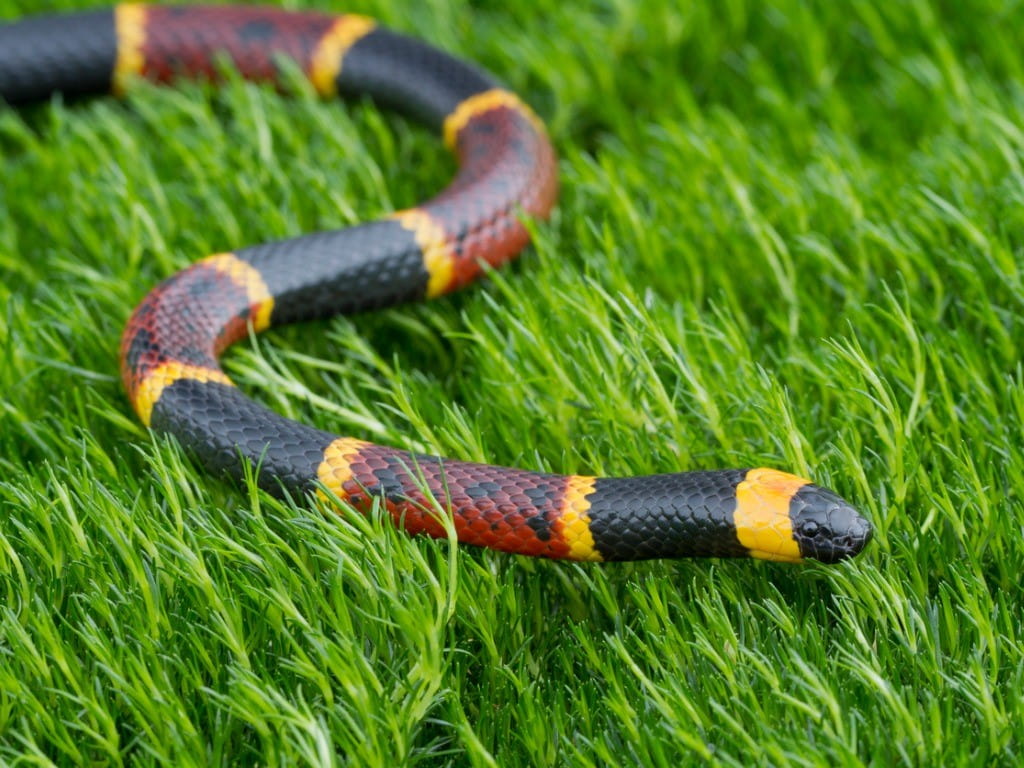Are Coral Snakes Poisonous?

The Bottom Line
Coral snakes usually have a pattern of red, black, and yellow (or white) colored rings that span their bodies. Although uncommon, coral snake bites can potentially lead to severe neurotoxicity, including complete respiratory failure, if left untreated. All suspected envenomations should be evaluated and monitored in a hospital for at least 24 hours due to the delayed onset of symptoms.

What do coral snakes look like and where do they live?
Coral snakes usually have a pattern of red, black, and yellow (or white) colored rings that circle their bodies. In addition to the color pattern, coral snakes have small rounded heads and tiny fangs.
This article focuses on the 3 coral snake species found in the US, which are:
- Eastern coral snake (Micrurus fulvius): Found in Florida and the southeastern US.
- Texas coral snake (Micrurus tener): Found in Texas and northwestern Mexico.
- Arizona or Sonoran coral snake (Micruroides euryxanthus): Found in southeastern US and Sonora, Mexico.
Are red and yellow snakes actually poisonous?
"Red touch yellow, kills a fellow; red touch black, venom lack." Of all the rhymes we've grown up learning, this one might be high on the list of ones to remember if you live in coral snake country in the United States. If you aren't familiar with this saying, it refers to distinguishing the venomous coral snake from its non-venomous look-alikes, such as the king snake, shovel-nosed snake, and milk snake.
Note that this rule does not apply to non-native coral snake species, which might have different patterns. So if you are in Central or South America, a “red touch black” snake may in fact be venomous.
Are coral snakes venomous?
Coral snakes are elapids, which are a family of venomous snakes that includes many species worldwide, including the cobra. Coral snakes and other elapids produce a venom that is neurotoxic, meaning that it blocks nerve impulses, causing paralysis. Fortunately, coral snakes are reclusive and seldom bite unless they are provoked or threatened. Compared to their pit viper counterparts, such as rattlesnakes, coral snake bites are uncommon and represent only about 2% of snake bites reported to poison centers in the US annually.
What are the symptoms of a coral snake bite?
Coral snakes have small, fixed fangs. When coral snakes bite, they tend to latch onto their prey and "chew" for a few seconds to deliver their venom. Compared to other venomous snakes, their bite marks can be easily missed, often showing no obvious signs of injury. The bite may even be painless.
However, even though there may be little pain or swelling, the coral snake can inject enough venom to cause serious illness. The potency of the venom varies depending on the species, with Eastern coral snakes having the most potent venom of domestic coral snakes. On the other hand, most Sonoran coral snake bites do not cause significant symptoms.
The effects of the venom are usually delayed several hours after the bite occurs, but progress rapidly once they develop. Symptoms of coral snake venom exposure can include nausea, vomiting, paresthesias (abnormal skin sensations like “pins and needles”), slurred speech, double vision, ptosis (drooping eye), muscle twitching, weakness, and paralysis.
The most serious effect associated with coral snake envenomation is paralysis of respiratory muscles, causing the victim to stop breathing. Despite what the rhyme says, deaths following coral snake venom exposure are exceedingly rare.
How are coral snake bites treated?
Given the potentially serious effects that can occur, all people with a suspected coral snake bite should be seen in a hospital immediately and observed for at least 24 hours after the bite. There is an antivenom available for coral snake bites, but not every hospital may keep it on hand. For this reason, when a bite occurs, healthcare providers need to work with their regional Poison Control Center to locate antivenom. Antivenom should only be given when a patient develops symptoms of envenomation. This is because some people can have serious allergic reactions to the antivenom.
Patients may need help breathing if the venom effects the respiratory muscles. This is usually done by placing the patient on a ventilator. There are other medications that may be helpful as well. Medical toxicologists and poison centers can help locate antivenom and make treatment recommendations.
What should you do if you are bitten by a coral snake?
If someone is bitten by a coral snake:
- Don’t panic. Snake bites can be treated and are often not as severe as people think.
- Don’t risk another bite by trying to capture or kill the snake. If you can take a picture or describe the snake, that can be helpful, but not essential.
- Don’t use old first aid remedies: no tourniquets, ice, or cutting the wound and sucking out the venom. None of these "treatments" help and most of them make things worse.
- Do keep the person quiet and still.
- Do keep the arm or leg (usual sites for snakebite) at the level of the heart.
- Do remove any jewelry, watches, and tight clothing from the area of the bite.
- Do wash the area gently with soap and water.
If someone is bitten by a snake, help from experts is available by phone at 1-800-222-1222. Poison Control’s expert guidance is always free, confidential, and available 24 hours a day. Poison centers have access to experts in identifying and treating snakebites who can help figure out if the bite is from a venomous or non-venomous snake. The experts will tell you what to do next, based on the information available and your symptoms.
Kristina Yee, PharmD
Certified Specialist in Poison Information
Revised Maryann Amirshahi, PharmD, MD, MPH, PhD
Medical Toxicologist
Poison Control Media Information
Did you find this page helpful? If so, we need your support. Poison Control is in constant competition with misinformation online. Links to www.poison.org or our webPOISONCONTROL triage tool from other websites and blogs help internet searchers quickly find accurate information and Poison Control’s contact information in an emergency. If you use the content from this page, please provide attribution via a link back to this page, www.poison.org, or https://triage.webpoisoncontrol.org/#!/exclusions. By doing so, you could save a life. Thank you!
Poisoned?
Call 1-800-222-1222 or
Prevention Tips
- Coral snakes aren't usually aggressive unless they feel threatened or are provoked. If you come across one, leave it alone.
- Look where you walk and look before you reach or grab something hidden. Turn on the lights if it's dark.
- Wear shoes when you go outdoors, as bites commonly occur in people walking barefoot.
This Really Happened
Case 1. A 9-year-old boy was bitten on the right index finger after a coral snake was thrown at him. He reported local and radiating pain at the bite site as well as abdominal pain. One hour after the incident, he was taken to a hospital and received 5 vials of antivenom. He was observed in the ICU and only developed mild local swelling. He was discharged after 3 days in the hospital.
Case 2. A 15-year-old girl was bitten on her arm by an exotic coral snake. She was taken to a hospital and observed in the ICU. She was not treated with antivenom because it wasn’t available. Her only reported symptoms were vomiting and swelling, and she was discharged after 3 days in the hospital.
Case 3. A 6-year-old boy was bitten while catching a coral snake. He developed anaphylaxis during antivenom administration. Nine hours after the bite he had drooling and difficulty swallowing and required mechanical ventilation for 8 days. He was discharged after 16 days in the hospital.
For More Information
Sartore J. Eastern coral snake [photo].Washington: National Geographic Society [cited 2020 Aug 31].
References
Pawar DK, Singh H. Elapid snake bite. Br J Anaesth. 1987 Mar;59(3):385-7.
Peterson ME. Snake bite: coral snakes. Clin Tech Small Anim Pract. 2006 Nov;21(4):183-6.
Poisoned?
Call 1-800-222-1222 or
Prevention Tips
- Coral snakes aren't usually aggressive unless they feel threatened or are provoked. If you come across one, leave it alone.
- Look where you walk and look before you reach or grab something hidden. Turn on the lights if it's dark.
- Wear shoes when you go outdoors, as bites commonly occur in people walking barefoot.
This Really Happened
Case 1. A 9-year-old boy was bitten on the right index finger after a coral snake was thrown at him. He reported local and radiating pain at the bite site as well as abdominal pain. One hour after the incident, he was taken to a hospital and received 5 vials of antivenom. He was observed in the ICU and only developed mild local swelling. He was discharged after 3 days in the hospital.
Case 2. A 15-year-old girl was bitten on her arm by an exotic coral snake. She was taken to a hospital and observed in the ICU. She was not treated with antivenom because it wasn’t available. Her only reported symptoms were vomiting and swelling, and she was discharged after 3 days in the hospital.
Case 3. A 6-year-old boy was bitten while catching a coral snake. He developed anaphylaxis during antivenom administration. Nine hours after the bite he had drooling and difficulty swallowing and required mechanical ventilation for 8 days. He was discharged after 16 days in the hospital.
